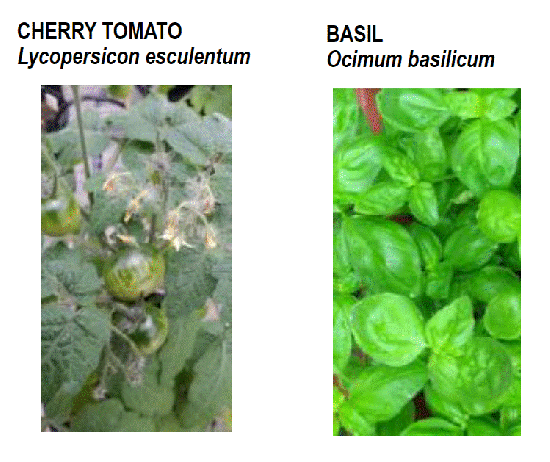Monash University, with funding support from the Horticulture Innovation Fund, ran a research project to improve the productivity and competitiveness of Australia's greenhouse producers of fruit, vegetables, herbs and plant-based medicinal health products through higher yields and enhanced nutritional value. The aim was to evaluate the effectiveness of PAS in increasing productivity and economic return in greenhouse cultured vegetables using tomatoes as a model.
"PAS materials alter natural sunlight & increase the ratio of light in the most photosynthetically active regions. This effect could improve yields but must be tested to understand the full impact of altered light environments on plant growth."
 Left: Cherry Tomato. Right: Basil
Left: Cherry Tomato. Right: Basil
The experiments were conducted on two horticultural crops: Cherry tomato & Basil.
This project aimed to determine the effect of PAS materials on:
- Plant growth (e.g. biomass, yield)
- Plant form (e.g. branching, leaf area)
- Plant developmental timing (e.g. flowering time, fruiting)
- Chemical composition of plant products (e.g. sugars, phenolic compounds)
Conclusion
Presentation: New technology for improving protected plant cropping PDF opens in new window (Note: this document does not meet WCAG 2.0 accessibility guidelines)
Potential for PAS technology to increase productivity of some crops through impact on:
- flowering time
- fruit yield
- photosynthetic rate
Indications of improved Quality:
- Early results suggest impacts on flavour through sugar content
- Potential benefits to nutrient content flowering time fruit yield photosynthetic rate
Species specific:
- Further investigation on wider range of crops needed to determine extent & impact of PAS technology
Background
Global food production is facing many challenges. With our world population expected to increase by 2 billion people before the middle of this century there is pressure on the agriculture and horticulture sectors to increase food production by at least 50%. Reaching this target is further complicated by the increased intensity and variability of weather events brought on by climate change. The food production industry must develop and adopt solutions which meet the nutritional demands of a large population while also minimising further contributions to climate change.
Protective cropping systems could provide a sustainable solution to this problem. Greenhouses can shield crops and reduce productivity losses associated with extreme weather events. The conditions within a greenhouse, such as temperature, can be manipulated to achieve ideal growing conditions for plants. Light quality plays an important role in plant growth and development and light emitting diodes (LEDs) are beginning to gain popularity as a way to manipulate the light environment of greenhouses used for food production. However, LED systems still require energy to run and require ongoing maintenance once installed.
PAS plastics offer a different method of optimising the plant growth environment. These materials alter the natural light provided by the sun through use of special dyes which absorb light in the wavelengths least utilised by plants for growth and move this energy to regions where it can be used most effectively for photosynthesis. This technology could result in greater yield and production for horticultural crops in a more sustainable way without the need for additional energy supply.
While PAS may help improve plant growth, changing the light environment could also impact on plants in other ways. Light signals are used extensively by plants to understand and respond to their environment. Altering the light environment may have unexpected or impacts on plant architecture (branching, leaf size), development (germination, flowering) and chemical composition (sugars, nutrient composition). These impacts could be commercially important and could differ depending on the dye material used, the species used or the specific plant product.
The experiments aimed to understand the impact of PAS materials on the growth, productivity and composition of two commercially cultivated horticultural species: cherry tomato and basil. These species were chosen as they are cultivated in Victoria and could provide an understanding of the impact of PAS on fruit quality as well as vegetative quality.